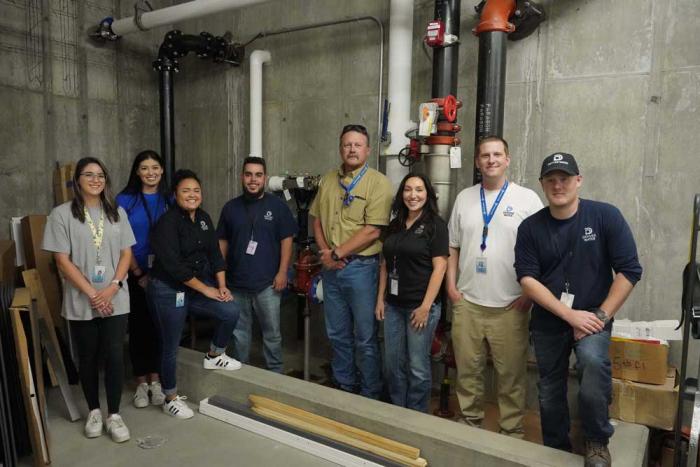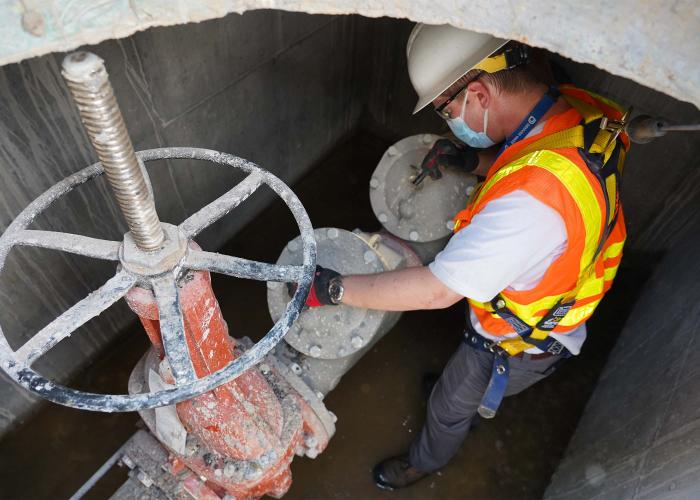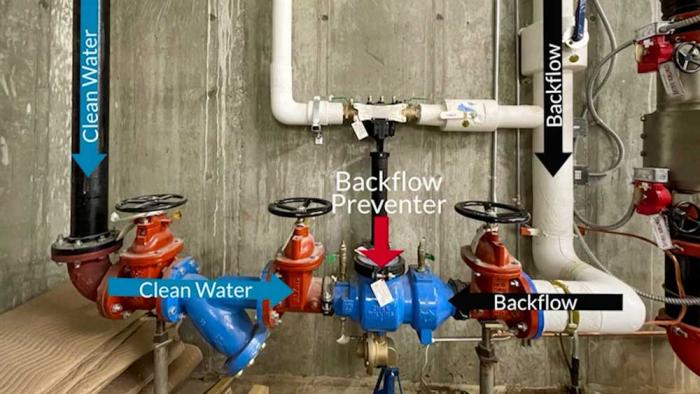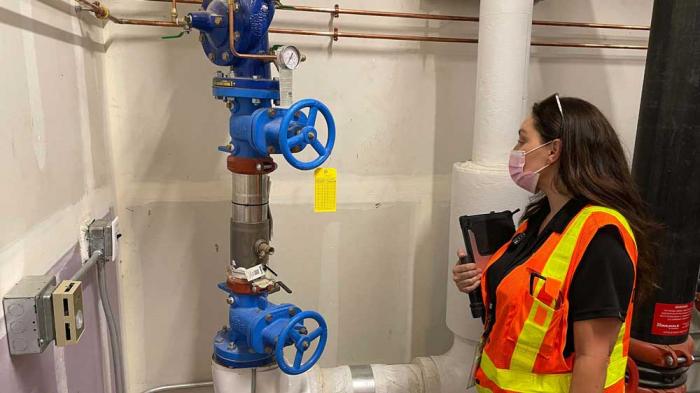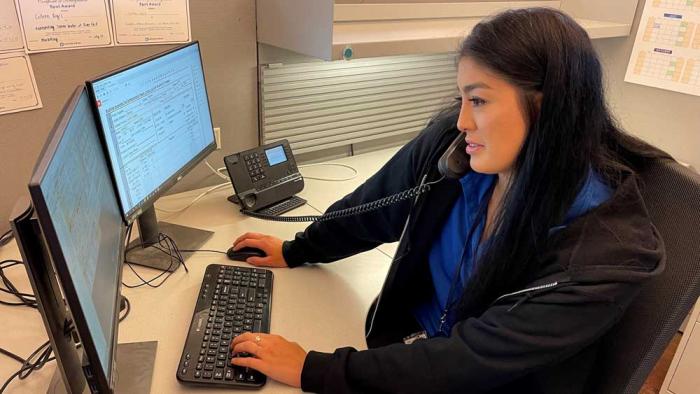Mission accomplished for the ‘Guardians of the Water’
You’ve heard of Marvel’s “Guardians of the Galaxy.” Now meet Denver Water’s “Guardians of the Water.”
In this episode, the “galaxy” is Denver Water’s service area, and the “guardians” are the utility’s Water Quality Operations cross-connection control team. The team is responsible for guarding Denver’s clean drinking water after it leaves the utility’s treatment plants and flows through 3,000 miles of pipelines to 1.5 million people.
Specifically, the team makes sure clean drinking water that’s reached a commercial or industrial customer’s location — such as a hospital, factory, restaurant, office building, warehouse or apartment complex, including irrigation systems — doesn’t accidently flow backward into Denver Water’s system and potentially send contaminated water to other customers.
In 2015, the cross-connection control team received a challenging mission from the Colorado Department of Public Health and Environment that even the galactic Guardians would have had a tough time completing.
New state regulations ordered all water providers in Colorado, including Denver Water, to conduct on-location site surveys to check the plumbing service connection between every industrial and commercial property and the larger public water system in each utility’s service area — and do it by 2020. In addition to industrial and commercial customers, the regulations also required water providers to check the connection at every residential property bigger than a duplex.
“Denver Water delivers water to more than just homes, and it’s used for more than just drinking,” said Brad McClintock, cross-connection control supervisor at Denver Water. “There are many industries that take the water we deliver and add other substances to it for their own uses. So we make sure that once we deliver water to them, it stays on their side of the connection.”
The new regulation meant Denver Water’s cross-connection team needed to complete about 32,000 site inspections in five years — a major effort for the small team, according to McClintock.
What is backflow?
Backflow of water through the service connection, where the public water system and the customer’s private plumbing connect, is a constant threat to public water systems. Incidents around the world have led to serious illness and even death for people drinking contaminated water.
“Unfortunately, backflow issues can and do happen,” McClintock said. “That’s why we’re out looking for problems and educating our customers about the risks and the role they play in ensuring a safe water supply.”
Backflow problems happen under two conditions: backsiphonage and backpressure, according to the American Backflow Prevention Association.
Backsiphonage is usually caused by a loss of pressure in the water system, such as when there’s a water main break. In this situation, water is no longer being pushed through a pipe, and water on the other side of the break can be sucked backward.
Backpressure problems can occur when the water pressure in a private business exceeds the pressure level Denver Water maintains in its delivery system. A pump that may be used to increase water pressure within a building’s plumbing could force water backward.
Backflow issues can happen at any type of customer site, including apartment buildings, restaurants, grocery stores, hospitals, laboratories, schools, offices, warehouses and at private wells.
Pipe connections where backflow problems can happen include:
- Drink dispensers hooked into the water supply.
- Agricultural product mixing plants adding chemicals to water.
- HVAC systems that use water for heating and cooling.
- Energy companies using water for refinery operations.
- Car washes that use pumps to clean vehicles.
- Irrigation systems.
- Fire protection sprinkler systems.
- Outdoor pools.
In incidents when water flows backward from a customer into the drinking water system, it’s considered either polluted or contaminated. Polluted water is safe to drink but is not aesthetically pleasing and may have taste and odor issues. Contaminated water can make you sick.
Backflow prevention assemblies
The way to prevent water from flowing back into a public utility’s pipes is to install a backflow prevention assembly.
These are devices installed between Denver Water’s delivery pipes and a business’s internal plumbing. The backflow preventer has check valves, so that if water unintentionally flows backward inside the business’s pipes, the check valves stop the flow from entering the larger clean water supply.
“Backflow prevention is a serious public health issue. If the proper devices aren’t installed correctly, people can get sick,” said Phil Hothan, water quality senior technician at Denver Water. “We’re always busy guarding our water supply.”
Drinking water safety
The importance of preventing water quality issues from unprotected cross connections is well known. The state has had requirements for backflow prevention devices since the 1960s and federal regulations were set forth in the Environmental Protection Agency’s Clean Water Act of 1974.
State and federal drinking water standards regarding backflow prevention have evolved over the years to provide more detail, and Denver Water has complied with regulations to ensure safe drinking water.
In 1985, the utility launched the cross-connection control team to improve its response to backflow incidents and inspect new and existing properties.
Denver Water had thousands of site surveys documented prior to state regulation changes in 2015, but it was still a big lift for the cross-connection team to complete the additional 32,000 customer inspections by the 2020 deadline.
Single-family residences and duplexes were not included in the new state regulations because they are considered low-risk sites for cross connection issues. Plumbing codes are designed to prevent water from flowing backward in a home’s plumbing system.
“During a site survey, we meet with the customer and check their backflow prevention device and check for any other places where they have connections to Denver Water’s delivery pipes,” said Erik Cancanon, water quality lead at Denver Water. “There may be just one or several connection points, so we have to be very thorough.”
The cross-connection control team had six members prior to 2015 and had to find ways to meet the state deadline. They added two full-time water quality technicians along with several part-time workers. The team also used Denver Water’s Continuous Improvement program to develop ways to streamline the site survey process, data entry and record keeping.
Problems discovered
During five years of site surveys, the team discovered major and minor problems.
Common issues included improperly installed backflow preventers, properties that had the wrong type of device, properties that didn’t have a backflow preventer and locations where a water supply pipe was tapped upstream of a backflow preventer.
When issues were discovered, the cross-connection control team has water quality technicians who follow up with customers to make sure problems are fixed.
“We always try to work with our customers, but in some cases, we do have to shut the water off to protect the water supply,” said Rochelle Garcia, cross-connection control team lead.
Since the new state regulations went into effect, the team has been issuing warnings or turning off water to about 200 customers each week until they make changes or prove they are in the process of fixing problems.
The team also has seen a dramatic increase in the number of phone calls they make to enforce the backflow rules — and an increase in calls from people with questions about the regulations, devices and proper installation.
“We take and make about 18,000 calls every year, talking to property owners, plumbers, backflow testing companies and engineers; it’s been very busy since the new regulations went into effect,” Garcia said.
Given that all commercial and industrial backflow assemblies are required to be tested annually, the team enters about 50,000 reports into Denver Water’s database to comply with additional state reporting requirements.
“At Denver Water, the safety of our water is our No. 1 priority, and that’s why the backflow prevention program is so important,” McClintock said.
“We don’t want people getting sick, so we are very strict about these rules, but once customers understand why we’re checking, they’re usually cooperative.”
The cross-connection team had to adapt to the challenges of COVID-19 in 2020, which made it more difficult to meet in person at customer properties due to new safety procedures. The state extended its December 2021 deadline because of delays caused by COVID-19, but the Denver Water team was still able to meet the state’s original deadline, completing its required site surveys by Oct. 2, 2020.
The team continues its mission to guard Denver’s water, doing site surveys on new properties and continuing to enforce annual testing requirements.
“I can’t say how proud I am of this team and what they accomplished over the past five years,” McClintock said.
“Our group understands how important backflow prevention is to keep the water safe. They’re just a really great team of dedicated professionals.”


